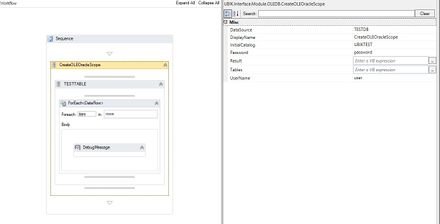Difference between revisions of "HowTo:Connect To Oracle With A Workflow"
| Line 1: | Line 1: | ||
| − | + | Prior to connecting to an Oracle database it is necessary to configure the connection to the server on your local environment. {{UBIK}} uses OLEDB to connecti to Oracle via TNS (Transparent Network Substrate). | |
| − | + | ||
| − | + | ||
| − | + | ||
| − | + | ||
| + | = Instructions = | ||
| + | # After the installation of the Oracle client you have to configure the Oracle server in the TNS Names: | ||
| + | ## Locate the file ''tnsnames.ora'' in the directory '''[ORACLESOFTWARE]\network\admin\''' | ||
| + | ## Configure the connection and call it (like in this example TESTDB): | ||
<code> | <code> | ||
TESTDB= | TESTDB= | ||
| Line 16: | Line 16: | ||
) | ) | ||
</code> | </code> | ||
| + | # Use the [[CreateOLEOracleScope (Activity)}} activity to configure the connection via the arguments: | ||
| + | #* the Oracle database '''DataSource''' | ||
| + | #* the '''InitialCatalog''' | ||
| + | #* '''UserName''' and '''Password''' | ||
| + | # Use the [[CreateOLETableScope (Activity)]] activity or a [[CreateOLEQueryScope (Activity)]] to define the table you want to fetch data from. Set the tablename in the '''DisplayName''' argument. | ||
| + | # Use a '''ForEach<DataRow>''' activity to iterate over the records fetched from the table. | ||
| + | # A column of the recordset (table) can be accessed by its index. | ||
| − | + | =Example Workflows= | |
| − | + | Connecting to an Oracle database and fetching data with the CreateOLETableScope activity<br /> | |
| − | + | [[File:ora_example_worfklow.JPG|440px|border|alt=Example Workflow|Example Workflow]]<br /> | |
| − | + | [[File:oratest.uwf|220px|border|alt=Example Workflow|Example Workflow]] | |
| − | + | ||
| − | + | ||
| − | + | ||
| − | + | ||
| − | + | ||
| − | + | ||
| − | + | ||
| − | + | ||
| − | + | ||
| − | + | ||
| − | + | ||
| − | + | ||
| − | + | ||
| − | [[File: | + | |
<br/><br/><br/> | <br/><br/><br/> | ||
Revision as of 12:33, 11 February 2015
Prior to connecting to an Oracle database it is necessary to configure the connection to the server on your local environment. UBIK® uses OLEDB to connecti to Oracle via TNS (Transparent Network Substrate).

